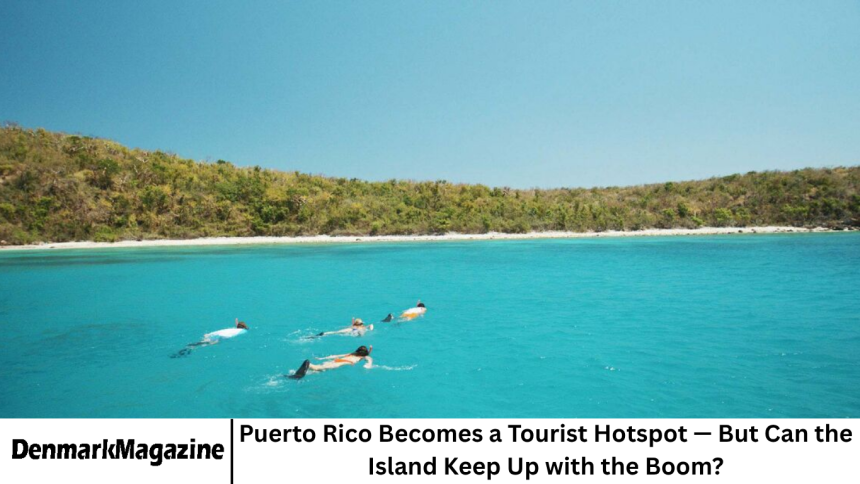Puerto Rico, the tropical gem of the Caribbean, is witnessing an unprecedented tourism boom. Once a relatively quiet destination favored by U.S. travelers for its blend of island beauty and American convenience, it has now become one of the hottest travel spots globally. With its turquoise beaches, vibrant culture, booming nightlife.
- The Rise of Puerto Rico as a Global Travel Hotspot
- Economic Boom: Tourism’s Impact on Local Growth
- Infrastructure Under Pressure
- Environmental Concerns: The Price of Popularity
- Social Impact: Locals Feel the Heat
- Sustainability Efforts and Green Tourism Initiatives
- The Future of Tourism in Puerto Rico: Balancing Growth and Preservation
- Frequently Asked Question
- Conclusion
And tax incentives drawing celebrities and entrepreneurs alike, Puerto Rico is basking in newfound attention. However, this surge in popularity raises an important question — can the island’s infrastructure, environment, and local communities handle the influx of visitors? While tourism has revitalized Puerto Rico’s economy post-hurricane.
And post-pandemic, it’s also straining the island’s resources and altering its social fabric. In this in-depth exploration, we’ll look at the factors driving Puerto Rico’s tourism explosion, the challenges it faces, and whether the island can sustain this rapid growth without losing its essence.
More Read: Samsung Partners with Coinbase to Expand Crypto Access for Over 75 Million Galaxy Users
The Rise of Puerto Rico as a Global Travel Hotspot
Over the past few years, Puerto Rico has experienced a remarkable tourism revival. Data from Discover Puerto Rico — the island’s official tourism organization — shows that visitor numbers have soared to record-breaking levels, surpassing even pre-pandemic highs.
In 2024 alone, Puerto Rico welcomed over 5.2 million tourists, generating billions in revenue and marking one of the strongest years for its hospitality sector. The island’s capital, San Juan, has become a hub for luxury travelers, digital nomads, and even remote workers seeking sun-drenched work-life balance.
Several factors contributed to this rise:
- Ease of Travel: As a U.S. territory, Americans don’t need a passport to visit Puerto Rico. This convenience became even more attractive post-pandemic when international travel was complicated by restrictions and paperwork.
- Tax Incentives: Puerto Rico’s tax laws, particularly Acts 60 and 20/22, attracted investors, influencers, and crypto entrepreneurs, creating buzz and stimulating luxury tourism.
- Social Media Exposure: Instagram, TikTok, and travel influencers have played a massive role in popularizing Puerto Rico’s beaches, old-town charm, and rainforest adventures.
- Celebrity Endorsement: From Bad Bunny’s global spotlight on Puerto Rican culture to high-profile real estate investments by American entrepreneurs, the island is now synonymous with cool, culture, and opportunity.
Puerto Rico, it seems, is having its moment — and the world has noticed.
Economic Boom: Tourism’s Impact on Local Growth
Tourism has become Puerto Rico’s golden ticket to economic recovery. After years of financial instability, hurricanes, and earthquakes, the resurgence of travel has breathed life into local businesses. Hotels, restaurants, and tour companies are thriving. Boutique stays in Old San Juan are booked months in advance.
Airbnb listings have doubled since 2019, and cruise ships have returned to San Juan Harbor at full capacity. According to the Puerto Rico Tourism Company, tourism now contributes over 10% of the island’s GDP. This boom has created thousands of jobs, particularly in the hospitality and service sectors, providing opportunities for young Puerto Ricans who might otherwise seek work on the mainland.
However, this success story comes with caveats. While many locals benefit from tourism, others feel left behind as prices rise and foreign investors scoop up prime real estate. The line between progress and exploitation has grown blurry.
Infrastructure Under Pressure
Despite its thriving tourism economy, Puerto Rico faces serious infrastructure challenges that threaten the sustainability of this boom. The island’s electric grid, still recovering from the devastation of Hurricane Maria in 2017, struggles to handle demand surges.
Blackouts remain frequent, and water shortages have been reported in popular tourist areas during peak season. Transportation is another pain point. Roads outside major cities are often poorly maintained, and public transport options remain limited. Rental cars are in high demand, leading to congestion and inflated prices.
Airports and ports have also reached their limits. Luis Muñoz Marín International Airport, Puerto Rico’s main gateway, is operating near maximum capacity, handling record-breaking passenger volumes.
Experts warn that unless Puerto Rico invests in resilient infrastructure — including renewable energy, sustainable transportation, and expanded accommodations — its booming tourism industry could face serious bottlenecks.
Environmental Concerns: The Price of Popularity
Tourism is a double-edged sword for Puerto Rico’s natural environment. While it promotes awareness and conservation, the sheer volume of visitors has begun to strain delicate ecosystems. The island’s beaches, especially Playa Flamenco in Culebra and Playa Buyé in Cabo Rojo, face erosion from overuse.
Coral reefs near popular diving spots show signs of bleaching, aggravated by pollution and climate change. The iconic El Yunque National Forest, the only tropical rainforest in the U.S. National Forest System, has seen a record number of visitors, leading to littering, habitat disruption, and pressure on local wildlife.
Local environmental groups warn that without proper regulation, Puerto Rico risks following the same over-tourism path seen in destinations like Bali and Hawaii. To combat this, the government has launched initiatives promoting eco-tourism and responsible travel, encouraging visitors to respect nature and reduce their footprint.
But enforcement remains inconsistent, and balancing preservation with economic growth continues to be a challenge.
Social Impact: Locals Feel the Heat
As tourism surges, not all Puerto Ricans are celebrating. The boom has brought with it a sharp rise in living costs and gentrification. Neighborhoods like Santurce and Old San Juan, once affordable for locals, are now dominated by short-term rentals and high-end developments.
Locals face displacement as landlords cater to tourists willing to pay premium rates. Moreover, critics argue that much of the tourism revenue benefits foreign investors rather than local communities. Many of the island’s luxury hotels and resorts are owned by mainland corporations, meaning profits often leave the island.
This tension has led to growing resentment among residents, some of whom view tourism as a form of “modern colonization.” Protests have erupted over the sale of public lands for private resorts and tax breaks for wealthy investors.
Nonetheless, grassroots efforts are emerging to make tourism more inclusive. Local cooperatives and community-based travel initiatives are promoting authentic cultural experiences while ensuring that the benefits reach Puerto Ricans themselves.
Sustainability Efforts and Green Tourism Initiatives
Recognizing the need for balance, Puerto Rico has begun steering toward sustainable tourism models. The Puerto Rico Tourism Company has launched several eco-certification programs encouraging hotels and tour operators to adopt environmentally friendly practices.
Key sustainability initiatives include:
- Eco-Certification for Lodging: Hotels that reduce waste, conserve water, and support local communities receive official eco-labels.
- Protected Marine Areas: The government has designated over 20% of its waters as protected zones to preserve coral reefs and marine biodiversity.
- Renewable Energy Projects: Efforts are underway to shift resorts and public infrastructure to solar power.
- Local Community Tourism: Projects in rural areas promote cultural immersion experiences, like coffee farm tours and traditional cooking classes, offering an alternative to resort tourism.
While these efforts are promising, experts say more investment and enforcement are necessary to make sustainability more than a slogan.
The Future of Tourism in Puerto Rico: Balancing Growth and Preservation
As Puerto Rico continues its ascent as a global travel hub, the challenge ahead lies in finding equilibrium — maintaining economic growth while protecting the island’s natural beauty and cultural identity.
Tourism is here to stay, but uncontrolled growth could jeopardize the very charm that attracts travelers in the first place. Thoughtful planning, inclusive policies, and collaboration between the government, private sector, and local communities are essential to building a resilient tourism model.
Experts recommend the following long-term strategies:
- Cap tourist numbers in sensitive areas like El Yunque and Culebra.
- Promote off-season travel to reduce environmental pressure.
- Support local-owned businesses to ensure wealth stays within the community.
- Strengthen infrastructure to withstand growing demand and climate challenges.
Puerto Rico stands at a crossroads. It can either follow the path of over-tourism that has burdened other island destinations — or become a model for sustainable, community-driven tourism in the Caribbean.
Frequently Asked Question
Why has Puerto Rico become such a popular tourist destination recently?
Puerto Rico’s popularity stems from a mix of convenience, natural beauty, and culture. As a U.S. territory, it offers easy, passport-free travel for Americans. Its stunning beaches, vibrant nightlife, and rich history have gained exposure through social media and celebrity attention, making it one of the most desirable Caribbean destinations.
Is Puerto Rico’s infrastructure equipped to handle the current tourism boom?
Not entirely. While major cities like San Juan are well-prepared, rural and coastal regions struggle with outdated infrastructure, unreliable electricity, and water supply issues. Significant investments are needed to modernize facilities and support long-term tourism growth.
How is the tourism boom affecting local communities in Puerto Rico?
The influx of tourists and investors has created economic opportunities but also led to gentrification and rising living costs. Locals in popular areas often face housing shortages as short-term rentals dominate. Balancing development with local needs remains a key challenge.
What environmental issues is Puerto Rico facing due to over-tourism?
Beaches are eroding, coral reefs are deteriorating, and natural reserves like El Yunque are under pressure from visitor traffic. Littering, pollution, and habitat disruption are growing concerns that require stronger environmental management and visitor education.
What steps are being taken to promote sustainable tourism in Puerto Rico?
Puerto Rico is implementing eco-certification for hotels, expanding protected marine areas, and encouraging renewable energy use. There’s also a growing focus on community-based tourism, where local residents lead tours and cultural experiences to ensure fair economic distribution.
Are tourists still welcome despite these challenges?
Yes, absolutely. Puerto Rico welcomes tourists warmly but urges them to travel responsibly — respect local customs, support local businesses, and reduce environmental impact. Conscious travel is key to ensuring that tourism benefits everyone on the island.
What does the future of tourism in Puerto Rico look like?
If current trends continue, Puerto Rico could solidify its place as the Caribbean’s premier travel destination. However, the island’s long-term success depends on sustainable planning, infrastructure upgrades, and local participation in decision-making. The future looks bright — if growth is managed wisely.
Conclusion
Puerto Rico’s tourism boom is a story of resilience, reinvention, and opportunity. From the ashes of economic hardship and natural disaster, the island has emerged as a shining example of how culture, beauty, and determination can rebuild an economy. Yet, the question remains: can Puerto Rico keep up with its own success?
The answer depends on the choices made today — how leaders manage growth, protect the environment, and include local voices in the conversation. If Puerto Rico can balance its booming popularity with sustainable development and community empowerment, it will not only sustain its tourism success but also preserve the soul that makes the island truly special.










